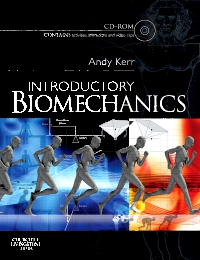
Introductory Biomechanics - Elsevier eBook on VitalSource, 1st Edition
Elsevier eBook on VitalSource

Now $40.91
An interactive text ideal for all health and sports professional students who require a basic understanding of the major biomechanical principles they meet in practice, including movement analysis and tissue mechanics. Starting from the point of zero-knowledge, this book presents what can be a very dry and difficult area, in an engaging and visual way using everyday objects to illustrate the principles and linking this to human anatomy and movement . Less time is spent on mathematics and classic mechanics with greater emphasis on how these principles are applied to professional practice
Introductory Biomechanics uses workbook–style learning diffusing manageable chunks of theory with learning activities and ultimately making the link back to clinical application. The accompanying CD is closely tied in with the text, containing video clips and real motion analysis data of walking, jumping, cycling and rising from a chair. There are also numerous animations of principles in action. The user is in control of most clips and animations and can change settings and manipulate variables practically showing biomechanics in action. The CD also contains a dynamic quiz drawing randomly from a pool of over 70 questions (MCQs, fill-in-the-blanks, true/false) which also provides feedback and percentage score on completion.
-
- Problems are posed to help students work through the theory and apply it to clinical scenarios
- CD offers thought-experiment activities, animations, video clips and scored quizzes to aid student learning
- Icons in text link to accompanying CD making the theory come alive
- Boxes containing additional information on many subjects extend knowledge or provide historical perspective to the principle in question
-
Introduction
Chapter 1 Fundamentals of force
What is force?
What does mechanical force do
Scalar or Vector?
Drawing vectors
Point of application
Force magnitude and change in motion
The force of muscles
Magnitude of moments
Direction of momentsChapter 2 Gravity, mass and stability
Gravity: the ultimate force
Centre of mass
Calculating the centre of mass.
Moments created by mass
Stability
Local and general stability
Standing balanceChapter 3 Force analysis: Graphs and maths
How do forces combine?
The Q-angle and knee pain
Measuring force
Using mathematics to resolve forceChapter 4 Forces and motion
Inertia
Moment of inertia
Linear momentum
Rotational momentum
Conservation of angular momentum
Newton’s second law: Impulse and momentum
Newton’s third law: Action and reaction
Bodies in contact: pressure and friction
Centre of pressure
FrictionChapter 5 Work and machines
Work
Muscles at work
Direction of work
Using machines to do work
Categories of levers
Velocity ratio
More advanced machines
Pulleys
The power of work
Efficiency
Practical problems on force and human movementChapter 6 Stress and strain
Definitions
Stress
Strain
Stress-strain relationship and stiffness
A few other properties of materialsChapter 7 Composition and mechanical properties of connective tissue
Connective tissue
Skin
Muscle
Bone
Articular cartilage
Tissue remodelling
Inactivity (immobilisation)
Maturation
Effect of ageing
Effect of recent history
Temperature
Science of stretchChapter 8 Flow
Relative density
Hydrostatic pressure
Archimedes principle, buoyancy and Pascal's law
Take the pressure off
Air pressure
Mechanics of flow
Drag
Bernoulli’s principle
Blood flow: haemodynamicsChapter 9 Energy and movement
What energy is
Potential and kinetic energy
Elastically stored potential energy
Energy conservation
Muscle energy
Measuring energy during movementChapter 10 Therapeutic application of force
Mobilization techniques
Static stretching
Respiratory techniques
Hydrotherapy
Orthoses
Dynamic wrist splints

 as described in our
as described in our 